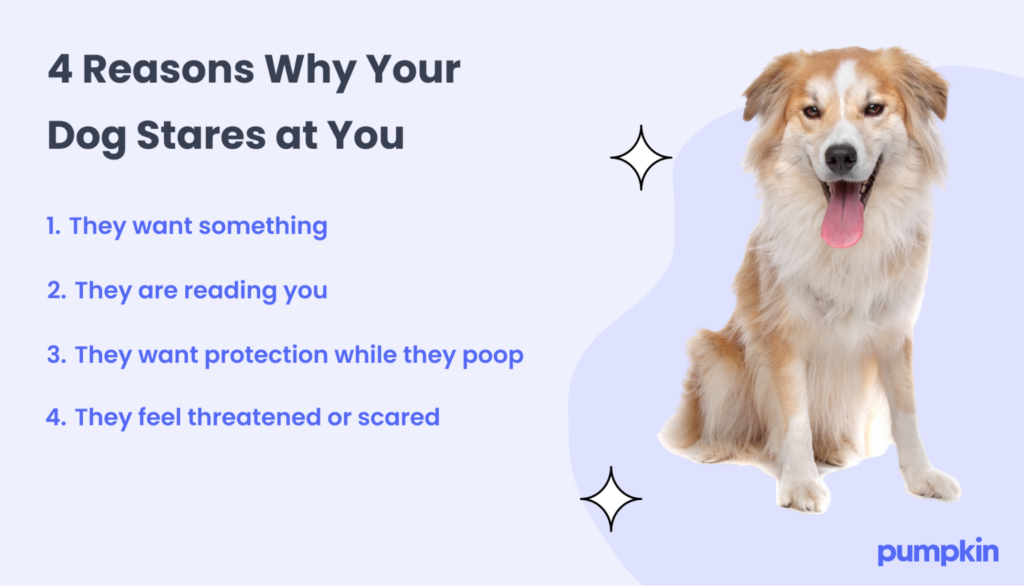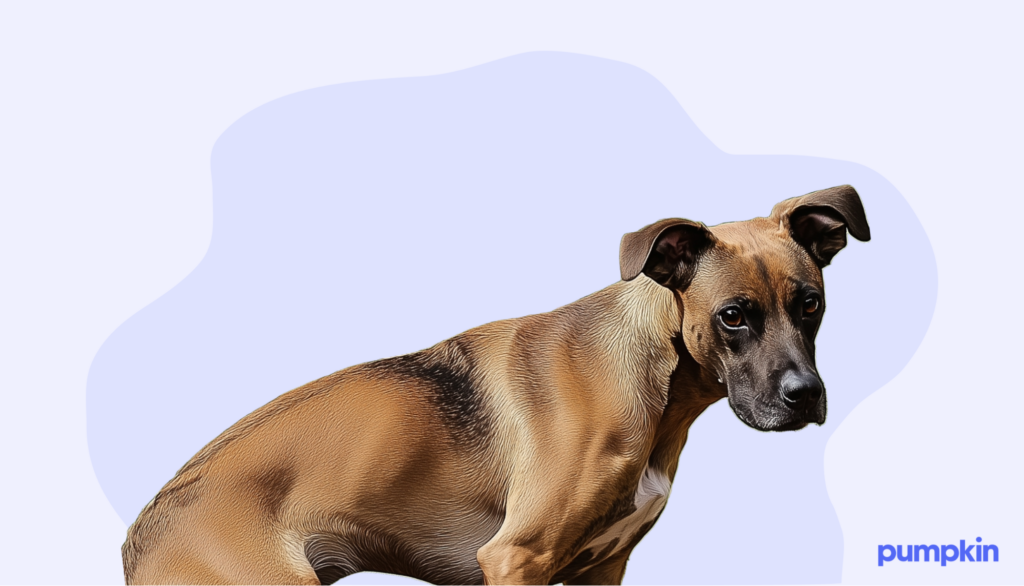Key Points
- Dogs stare for different reasons, including to communicate, anticipate, warn, or seek protection.
- Understanding your dog’s stare and body language can help you better meet their needs.
- Eye contact with dogs strengthens your bond and communication.
You know that look your dog gives you — the one that could guilt trip any human into sharing a bite of their dinner. But, what about all the other times you catch them staring at you and food isn’t the motivator? Are they begging for another belly rub or a potty break, or could it be that something is wrong?
Dogs may not speak our language, but their eyes can tell a thousand stories if you know how to interpret them. So, let’s decode those soulful puppy-dog stares and figure out what your dog is really trying to tell you with that look.
The benefits of eye contact between humans and dogs
Eye contact between a human and their dog is more than a cute moment — it’s a powerful communication tool that strengthens your bond and builds trust with your pup.
Strengthened bonds
Ever locked eyes with your furry friend and felt an undeniable connection? There’s a reason for that!
Studies have shown that when a bonded dog and human stare into each other’s eyes, a hormone called oxytocin (also known as the “love hormone”) is released into the bloodstream of both the dog and human.
When oxytocin is released into the blood, it has a calming effect, reducing anxiety and providing a sense of security for both parties. The trusting bond and love between a dog and their human is largely because of these chemical reactions.
Interestingly, another study has shown that wolves — the ancestors of domesticated dogs — do not produce oxytocin from staring. They see it as a sign of aggression. So, the production of oxytocin may have been a key step in the evolution and eventual domestication of wolves and dogs.
Mutual understanding
While you may not be able to have full-blown conversations with your dog like Doctor Dolittle, their eyes tell us a whole lot about what they’re thinking.
Whether it’s begging for a treat, a quick potty break, or a game of fetch, you can better understand your dog’s emotions, intentions, and needs by observing their gaze.
But the communication goes both ways. Through eye contact, dogs can also become attuned to their human’s emotions. They can read your expressions and sense your feelings. That’s why they’re often the first to comfort us when we’re feeling down.
Improved cooperation
Focused eye contact makes it easier for your dog to understand what you’re asking of them. When your dog focuses on you, they’re more receptive to your commands and cues. This means faster, more effective learning outcomes.
As your dog learns new skills, they gain confidence, which makes them even more willing to cooperate and learn new things. Complex tasks like agility, search, rescue, or even emotional support work become attainable goals with the help of some extra eye contact.
4 reasons why dogs stare at you
What exactly is your dog trying to tell you with those big, expressive eyes? Let’s dive into five common reasons why dogs stare at you:

1. They want something
Dogs often stare at us when they need something: usually basic needs like food, a walk, or some extra attention and pets.
Dogs are creatures of habit and routine. They know when it’s time for their walk, their playtime, or their dinner. You’ve probably noticed your dog showing up for dinnertime like clockwork. If you’re distracted or slacking, they’ll let you know it’s time for dinner with that look.
Sometimes those stares are just a clever ploy to guilt you into giving them something delicious to eat. The begging stare is common when they smell your tasty people food, especially if you’ve accidentally rewarded this behavior in the past by sharing your snacks.
Although there are a few that can always resist those puppy eyes, too much people food is not good for a dog’s diet, especially if they’re overweight or have dietary restrictions.
Dogs can also stare at you when they aren’t feeling well. If your dog is staring intently and seems distressed, don’t hesitate to contact your vet. Consider investing in pet insurance to help cover future unexpected vet bills.
2. They are reading you
If you ever catch your dog staring at you intently without an apparent need, they might be reading you. This is their way of gathering information about your emotions and intentions. By constantly observing you, they can predict what you might do next.
Dogs are experts at recognizing subtle cues, body language, and facial expressions, like a smile or a furrowed brow. They learn to associate those cues with specific emotions and behaviors.
Dogs, especially those trained with positive reinforcement, are good at watching their pet parent for cues. In fact, teaching your dog to look at you using a verbal cue, such as “watch me,” helps them focus on you and not on other distractions around. But if your dog keeps staring with a tilted head, it might mean they’re a bit confused. Don’t worry, just keep practicing those cues and they’ll catch on in no time.
3. They want protection while they poop
This one might seem a bit awkward, but it’s normal for your dog to stare at you while they’re doing their business. To them, pooping puts them in a vulnerable position where they can’t easily escape or defend themselves.
This natural behavior likely stems from their wolf ancestors who rely on their pack to keep watch while they are vulnerable. Since many dogs view their human family as their pack, that makes you their pack leader and protector.
So while it may be strange, this look is a sign that your dog trusts you deeply. It’s their way of saying, “I know you have my back.”

4. They feel threatened or scared
Not all staring is good staring. Sometimes it can be a sign of aggression, especially if the stare is coming from a dog who doesn’t know you.
If a dog feels frightened or threatened, they will show a “hard stare”, accompanied by a stiff posture, a closed mouth (sometimes with exposed teeth), and wide pupils. This is very different from a “soft stare,” with a relaxed body posture, open mouth, and sometimes light panting.
If an unfamiliar dog gives you a hard intense stare, it’s best to avoid direct eye contact and slowly back away, as they see you as a threat. Even if it’s your own dog who’s just settling in, a hard stare means they need some space — and that’s okay! All dogs have to learn to trust their humans, and it’s perfectly normal for a new pup to feel frightened before you’ve fully bonded.
Sometimes, dogs get protective of their toys, food, or even their favorite human. This is what is known as resource guarding, and it can be a signal that they are about to act aggressively. If you notice this behavior in your dog, it’s a good idea to chat with your vet or see a dog trainer for advice.
The bottom line: A staring contest
The next time you catch your dog staring, remember that they’re trying to connect with you. Take a moment to acknowledge their loving gaze and try to understand what they are telling you with those puppy-dog eyes.
By recognizing the meaning behind your dog’s stares, you will be better equipped to provide what they need — whether that’s a walk, a snack, some extra attention, or even a little space.
While it might seem like the stare always about food (and let’s be honest, maybe half the time it is), your dog’s stare can speak volumes about their love, trust, and need for connection with their favorite humans.
FAQs
- https://www.science.org/doi/10.1126/science.1261022
- https://www.ncbi.nlm.nih.gov/pmc/articles/PMC4826871
- https://www.akc.org/expert-advice/training/training-rewards/
- https://defenders.org/blog/2014/07/wolves-are-even-more-socially-complex-we-thought
- https://www.thekennelclub.org.uk/health-and-dog-care/health/health-and-care/a-z-of-health-and-care-issues/why-does-my-dog-follow-me-everywhere/
- https://www.akc.org/expert-advice/training/dog-separation-anxiety/



